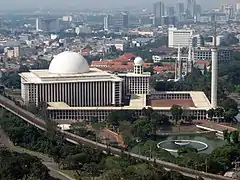Sunan Giri
Sunan Giri (also called Raden Paku or Joko Samudra), Muhammad Ainul Yakin (born 1442 CE in Blambangan (now Banyuwangi) is considered to be one of the Wali Sanga of Indonesia.
Kangjeng Susuhunan Giri I (ꦏꦔꦁꦱꦸꦤꦤ꧀ꦒꦶꦫꦶ꧇꧑) | |
|---|---|
ꦫꦝꦺꦤ꧀ꦥꦏꦸ | |
 Sunan Giri painting | |
| Pronunciation | Radhen Paku |
| Born | Raden Paku 1442 M |
| Died | 1506 M |
| Other names | Raden Paku Prabu Satmata Sultan Abdul Faqih Sayyid Muhammad 'Ainul Yaqin Joko Samudro |
| Era | Majapahit, Demak Sultanate, Cirebon Sultanate |
| Organization | Walisongo |
| Title | Kangjeng Susuhunan Giri |
| Parents |
|
| Family | Wangsa Azmatkhan |
History
He was the son of Dewi Sekardadu and Maulana Ishak of Melaka (brother of Maulana Malik Ibrahim), but later adopted as a son by Nyai Semboja (a female merchant[1]). A traditional story says that he was the son of a Hindu princess, who had come to Blambangan as a missionary. The princess was forced to abandon him in a crisis and set him adrift on the ocean in a small boat, from which he was rescued by sailors, a story reminiscent of the Biblical Moses.[1] (see Sejarah Banten).
His tomb is at Sunan Giri Mosque, near Grisik, 45 km from Surabaya.
Education and contributions
As a young man Sunan Giri studied in the school of Sunan Ampel, whose daughter he eventually married,[2] and where Raden Patah was his fellow student.
He later established his own school in Desa Sidomukti at Southern Gresik in East Java—a location from which he got his name ("Giri" means "hill").[3] The Islamic School which he established was not only an institute of religious studies, but also center for various local civic activities and social development.
Political leadership
The king of Majapahit granted Giri the authority to expand his role in political leadership, which later on to lead to the greater development of the school, popularly known as Giri Kedaton. Sunan Giri was also known as Prabu Satmata, due to his remarkable record.
Sunan Giri foretold the rise of Mataram, and spread Islam to Lombok, Sulawesi, and Maluku. He was a proponent of orthodox Islam, and disapproved of innovation (much like "modernist" Islamic scholars of the 1800s and 1900s).
Later history of the Giri Kedaton school
Giri Kedaton, as a center of religious and political authority led by century head Pangeran Singosari was known for his most persistent resistance to the Dutch VOC and to Amangkurat II, who collaborated with the Dutch colonization efforts.[3]
The creation of popular children's toys and games such as Jelungan, Jamuran, lir-ilir and Cublak Suweng is attributed to Sunan Giri. His name is also associated with Gending Asmaradana and Pucung (Javanese poetry)—although they had been mostly influenced by pre-Islamic Javanese beliefs and traditions, but show signs of eventual Islamization.
See also
References
- Ricklefs, M.C. (1991). A History of Modern Indonesia since c.1300, 2nd Edition. London: MacMillan. p. 10. ISBN 0-333-57689-6.
- Wali Songo: The Nine Walis
- al-shia.com
- Sunyoto, Agus (2014). Atlas Wali Songo: Buku Pertama yang Mengungkap Wali Songo Sebagai Fakta Sejarah. 6th edition. Depok: Pustaka IIMaN. ISBN 978-602-8648-09-7
External links
| Wikimedia Commons has media related to Sunan Giri. |

